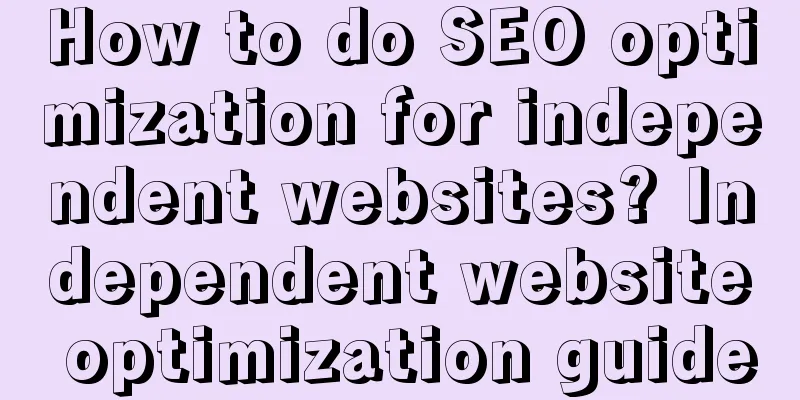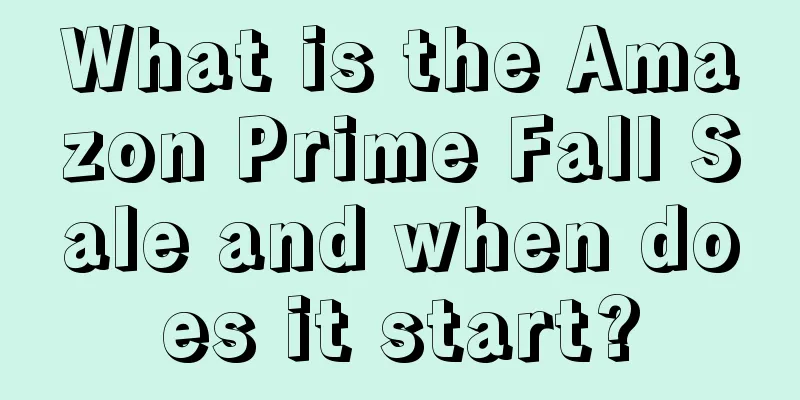How to do SEO optimization for independent websites? Independent website optimization guide

|
More and more people want to enter the independent station field, build their own brand position in the independent station field, and acquire more customers. If you want your website to be discovered faster, in addition to advertising, there is SEO. SEO can help your website get a better ranking in search engines, thereby attracting more potential customers to our website and completing transactions. Next we will introduce some SEO points that you need to pay attention to when building a website. 1. Website structure optimization 1) Ensure the website structure is clear A clear website structure can not only improve user experience, but also make it easier for search engines to crawl website information. We can optimize our website structure from the following points: 1. Design a clear website navigation bar to facilitate users to quickly browse website content We can set up website navigation based on keyword clusters. Keyword clusters are users' search intentions and search needs, which makes our website navigation meet users' search intentions. As shown in the following figure, this website for cosmetic contact lenses, we analyzed keywords and found that the major keyword clusters are related to color, style, and usage scenarios, so its navigation is set up like this (see the figure below). Think about why it doesn't set up the website navigation according to material or pattern, because people's search needs are not based on these. 2. Use a Clear Site Map The purpose of the sitemap is to let Google understand the structure of our website and quickly crawl and index our important pages. Therefore, our website must have a sitemap and submit our sitemap in GSC. 1) How do I submit a sitemap? The sitemap of a Shopify website is generally https://yoursitename.com/sitemap.xml. Submit this link on GSC. We can also generate a sitemap in similar online sitemap generation tools such as https://www.xml-sitemaps.com/. Place the HTML site map link of the entire website at the bottom of the website navigation to facilitate Google crawling of website pages, as well as users' actual searches and visits. 3. Use a meaningful URL structure URL is also an important channel for Google to understand the page, so our URL must be related to the topic, rather than set randomly. So what are the key points for URL optimization? First, the URL of our page should include the target keyword of the page as much as possible. This tells Google that our page is about this keyword topic. Google also said that URLs containing words related to the content and topic of the website are more friendly to visitors browsing our website. Second, the URL should be short and clear in subject, and do not use keyword stuffing. Long URLs will confuse Google and users. Third, do not use the default URL. Some URLs are the same as the page title by default. If the title is long, the URL will also be long, especially in product pages. Some URLs have date numbers such as year, month, and day by default, which is not good for us to update the content later, because Google and users like fresh content. If the URLs are all dates from a few years ago, we may lose some clicks. Some default URLs contain some strange characters or parameters, which are not conducive to Google and users to understand our pages. Fourth, use hyphens to clearly separate words in the URL to let search engines know that the words in the URL are independent words and not to pile all the words together. In addition, the structure of the URL will affect the crawling index and weight of the page, so we must also pay attention to the URL depth of key pages. For important pages, the closer to the root domain, the better (in fact, the lower the URL depth, the better), because the root domain usually has the highest PageRank, and the closer the page is to the root domain, the higher the PageRank may be. So, if we create an important landing page, we try to make its URL structure simple and closer to the root domain, so that it is easier to rank. 2. Content Optimization 1) Content Quality Content is the core of a website and one of the important factors in SEO ranking. Only high-quality content will be recognized by Google and displayed and ranked. So what do we need to do to improve the quality of content? 1. Ensure content originality Google prefers original content, so our article content should not be directly copied and simply rewritten. This is a pseudo-original practice. Copying other people's articles may have repetitions in the theme and logic, and the main content may also be repeated. Therefore, it is best for us to first determine the topic of our article, then determine the content outline, and then create the content according to the outline to ensure the originality of the content. Other people's articles can only be given to us for reference, and cannot be directly copied and pasted. Tools to check content originality: 1) Originality check quetext.com duplichecker plagiarisma.net copyscape.com 2) AI content detection tools originality.ai Copyleaks AI Openai ai text classifier writer aicontent detector 2. The content is relevant to the topic Usually, we find the right topic for our in-site articles from the perspective of keyword analysis or core user model characterization, and then use keyword clusters, content analysis tools, and competitor related topic structures to develop our own article outline based on the topic, and then write our content based on the outline. The content written through this process must be closely aligned with the topic and will not deviate from the topic in any paragraph of the article. How to choose a theme: 1) Select article topics based on core user model characterization Take the example of the prescription colored contacts for dark eyes Core customers: Customers with dark eye color, myopia or astigmatism Usage scenarios: class, work, date, nightclub party, short video recording, Halloween, performance, street shooting, studio shooting, etc. Example: What is the most natural prescription colored contact lenses for dark eyes 2) Identify the problems that users may encounter based on the user life cycle as the topic 3) Check out what topics your competitors are writing about How to write an outline based on the topic: After deciding on the topic, we know what we want to write about, so the next step is to write an outline of the content. There are the following ways to expand the outline: 1) Write based on the small keyword clusters under the theme keyword cluster 2) AI tools help write article outlines 3) Content tools such as SEMrush help write article outlines 4) Learn from the content outline of the authoritative information platform of competitors Write your content according to the outline: After the content outline is sorted out, we can write the content according to the small themes of the outline. So when writing content, how can we find more content inspiration? There are some methods: 1) Search keywords on Google to view industry news and information websites 2) AI tools input keywords and outlines to assist in writing content 3) Enter keywords on large social platforms to obtain relevant content 4) Enter keywords on large shopping platforms to obtain relevant content 5) Enter keywords on the video platform to obtain relevant content 6) Enter keywords to search for competitor content 3. Keyword placement in content 1) How to plan keywords for the homepage The target keyword is the keyword with a competitive advantage among the core keywords. If it is a brand website, the brand name + core keyword is the target keyword of the homepage. Target keywords are placed in the front of the meta title and meta description The target keyword should be at the front of the first paragraph of the text, and should appear in the first 200 words. Other variations of the core word can be placed in H2, H3 and the body of the text. Keywords from other key clusters can be placed in the body of the article, and the density of target keywords should be controlled at around 2%. 2) How to plan keywords for category pages The target keyword is the most competitive word among the core words in the classification keyword cluster. Target keywords are placed in the front of the meta title and meta description The target keyword should be at the front of the first paragraph of the text, and should appear in the first 200 words. Other related keywords under the target keyword cluster can be placed in H2 and H3 The layout of keyword clusters and other related keywords in the text, the density of the target keyword is controlled at about 2% 3) How to plan keywords for product pages The target keyword is the product keyword. If it is a brand site, it is the brand name + product keyword. The target keyword is placed in the front of the meta title and meta description. The target keyword should be at the front of the first paragraph of the text, and should appear in the first 200 words. Other related keywords under the target keyword cluster can be placed in H2 and H3 The layout of other product related keywords in the text, the density of the target keyword is controlled at about 2% 4) Keyword planning principles for blog pages The target keyword is the most competitive keyword in the keyword cluster. Target keywords are placed in the front of the meta title and meta description The target keyword should be at the front of the first paragraph of the text, and should appear in the first 200 words. Other related keywords under the target keyword cluster can be placed in H2 and H3 The layout of other related keywords in the text, the density of the target keyword is controlled at about 2% 2) Content Update Updating website content is an important means to maintain website activity and improve SEO rankings. So how do we update website content? 1. Create new content 1) Find more industry topics through keyword analysis and competitor analysis, and then write more content. In this process, we can use various tools, such as Google Keyword Planner, SEMrush, etc., to find more theme keywords in the industry, and write more content based on these theme keywords to attract more users. 2) Add new content types, such as pictures, videos, audio, etc. Users are increasingly fond of multimedia content, and multimedia content can increase the time users spend on the page. Therefore, we can attract more users and improve the quality of content by adding multimedia content such as pictures, videos, and audio. 3) Use UGC (user-generated content) to increase website content UGC refers to user-generated content, which is the content generated by users on our website, such as comments, messages, pictures and videos. Using UGC is a good way to increase website content while ensuring the quality of the content. By attracting users to participate in generating content, you can not only increase website content, but also improve user engagement and stickiness. 2. Update old content In fact, updating old content is more effective than creating new content. If the old content has been included and has a certain ranking and traffic, then our update of the old content is icing on the cake, which can make their rankings go to a higher level. If the quality of the old content was not high before, then our update can improve the quality of a single page, thereby improving the overall quality and weight of the entire website. Therefore, it is important to update old content. 1) Use data analysis to find content that does not perform well, re-analyze topics and keywords, write a content outline, and rewrite the content. 2) Find content with thin content, re-analyze the topic and keywords, write a content outline, and re-write the content. 3. Improve website loading speed 1) Optimize image format and size 1. Use the correct image format, such as PNG, JPEG or WebP, webp is better. 2. Use images of appropriate size, compress them using imagemin, or use other image compression plugins to compress them. 3. Use video instead of GIF. If there is GIF on the web page, try to convert it into video, as GIF animations are relatively large. 4. Use responsive images to suit browsing on different devices. 5. Use CDN images to reduce the size of image file transfer. 6. Lazy loading of off-screen images, using lazysizes codelab Lazy loading of off-screen images 2) Optimize Video 1. Delayed loading of videos: Videos on the page, especially those outside the screen, can be delayed. This can increase the speed of page loading. 2. Use external video hosting platforms, such as YouTube, Vimeo, or Wistia, to save space and speed up loading 3) Optimize CSS 1. Lazy loading of non-critical CSS 2. Minify CSS 3. Remove unused CSS 4. Extract critical CSS |
<<: What are the advantages of Amazon's eight major sites? What are the eight major sites?
>>: What does IP leak mean? How to prevent it?
Recommend
Can Amazon export tax rebates be obtained? What are the tax rebate rules?
As the Amazon platform continues to grow, more and...
Some people make a fortune by selling short videos of misery, but you are still kept in the dark
With the progress and development of the times, th...
Advertisers, please check: 6 love letters from brands
What new styles will brand copywriting have this V...
My minimalist information management method
Information needs to be managed because it is high...
Can Shopee directly ship to mainland China? Can it ship to mainland China?
If users want to shop on Shopee, they need to regi...
What is “one inventory” across all channels?
Omni-channel "one inventory" is an impor...
How can brands create targeted content for the back-funnel population?
This article mainly introduces a marketing strateg...
Why is Amazon slow to pay back? What is the reason for payment delay?
Many people like to shop on Amazon. The most impor...
The key logic of brand building
This article analyzes the key logic of brand build...
Dong Yuhui's new account premiered, earning over 150 million viewers overnight
Dong Yuhui took on the lead role for the first tim...
The good news is that the advertising fees in the drama market are back again!
When we thought that all brand advertisements were...
What is the process for new sellers to join Amazon? Super detailed entry process
As a new seller, you may be confused about how to ...
The average GMV per game is less than 25,000. The Oriental Selection has hit a wall.
Oriental Selection recently developed a new busine...
The pre-sale of 618 is cancelled this year. Are the anchors worried?
During the 618 promotion in 2024, e-commerce platf...
How can a newcomer find foreign customers in foreign trade? Method introduction
When doing foreign trade, there is one skill that ...









